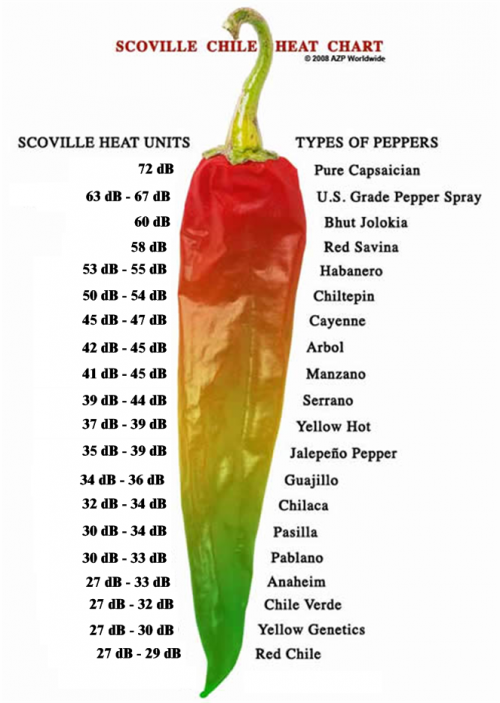Quote of the Day
It takes as much energy to wish as to plan.
— Eleanor Roosevelt
Introduction
You never know what you will see when you walk into a guy's cube. I went to an engineer's cube with a simple question on some electronic parts and I left with an education on chili peppers. My education began when I looked at his bookshelf and noticed that it was filled with various hot sauces, a dead giveaway that I was in the presence of a man who likes his heat. I also noticed the following chart on one of his walls (Figure 1).
Some of you may be familiar with the Scoville scale, but I was not. As far as culinary heat is concerned, I break into a sweat just walking near a Jalapeno pepper.
The Wikipedia has good discussion of the Scoville scale and its history, so I will not go into that here. My interest is in the dynamic range of the Scoville scale. Pure capsaicin, the heat-producing component in chile, has a Scoville rating of 15,000,000. A Belle pepper has a Scoville rating of near 0.
It is rare to see this kind of dynamic range in everyday life. It is here that I see a good use for decibels ...
Convenient Numbers
For those of you who are not familiar with the decibel (abbreviated dB), it is computed as shown in Equation 1.
| Eq. 1 |
I use decibels everyday, but I have never really liked them. Much of my dislike has to do with how they are used. I see people treat decibels as a unit, but they really are not a unit – decibels are a scaling. I see two main reasons to use decibels.
- To compress physical measurements into a more friendly-number range.
Human beings can only visualize a limited range of numbers. Because of our decimal orientation, engineers frequently try to use scalings that put frequently used numbers in the range of 0 to 100. The decibel does compress an amazing number of physical quantities into the range of 0 to 100. - The decibel converts multiplication into addition.
This is the most important feature of the decibel and why engineer's specify so many system parameters in decibels. Because many systems have transfer functions that involve products of numbers, the use of decibels allows one to compute complex values using simple addition.
So while I see uses for the decibel, some guys take it to a ridiculous level. I know of at least one engineer who can figure out interest rates, car payments, and all sorts of compound interest calculations in his head by using dBs. It may be hard to believe, but even I think that is obsessive.
Anyway, I think that the Scoville range of 0 to 15,000,000 is way too big for a human to visualize. I think that dB could help here. Figure 2 shows Figure 1 expressed in dB. I think these numbers are easier to work with.



The dB figures are nice - numerically. They do nothing to warn me off of the Bhut Jolokia (Ghost Pepper) because 60 is only a little bit more than the 47 of a pepper I am more familiar with. I prefer the Scoville scale for peppers.
I understand. The main point of my post was to discuss the way people work to get numbers into "human-friendly" ranges. I agree that the Scoville scale gives you a more intuitive feel for the heat of a pepper.
Of course, but ingeneral people don't understand Decibels anyway. And as for Chillies I just grow 'em, can't eat 'em!